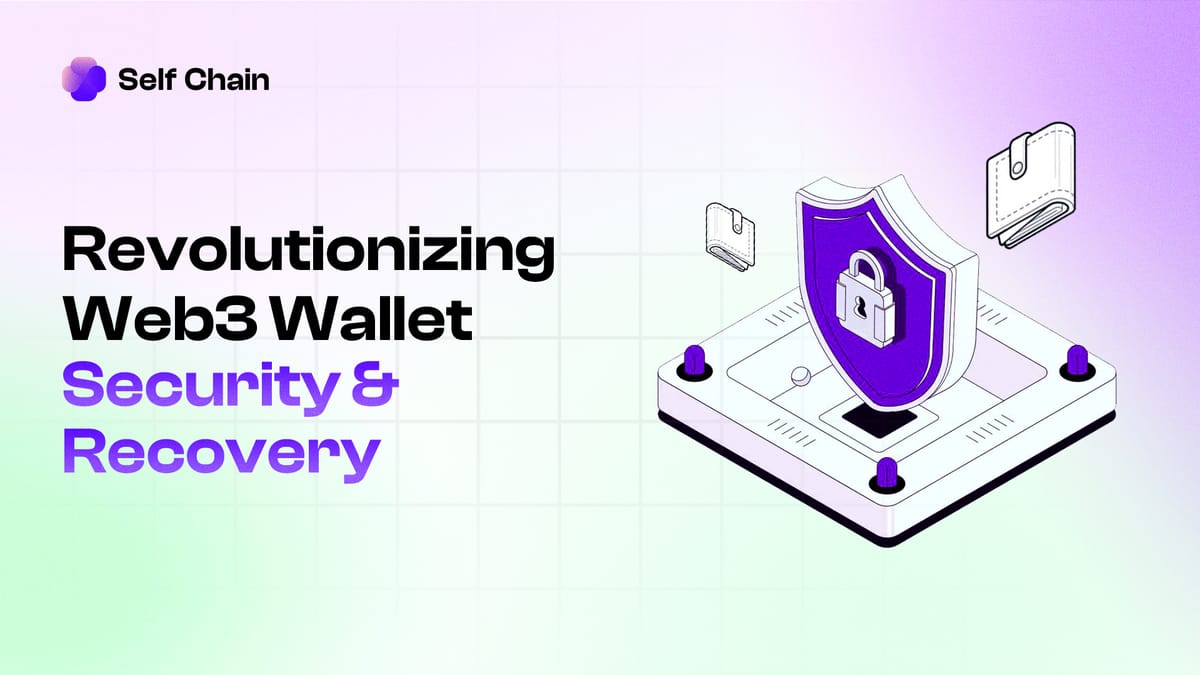Revolutionizing Web3 Wallet Security & Recovery

Introduction
Self-custody in Web3 has historically relied on seed phrases and static private keys. While simple in design, these models suffer from a critical weakness: a single point of failure. Lose the phrase, and access is gone forever. Expose it, and control is lost instantly. Self Chain addresses this challenge with a keyless wallet architecture that integrates Multi-Party Computation (MPC-TSS), Account Abstraction, and Decentralized Identity (DID) to deliver a system that is both secure and recoverable without undermining user sovereignty.
Cryptographic Foundations: MPC-TSS
At the core is Threshold Signature Scheme (TSS), a form of MPC where a private key is split into independent shares. Each share alone is useless, but together (meeting a predefined threshold) they generate a valid signature. Importantly, the private key is never reconstructed in full at any stage of the process.
Self Chain implements a three-share structure:
- Personal Share: stored securely on the user’s device.
- Remote Share: distributed across Self Chain’s secure modules.
- Recovery Share: tied to a Decentralized ID and used for account recovery.
Transactions typically use Personal + Remote shares. Recovery scenarios rely on the Recovery Share.
Resilience Through Share Refresh
Key shares are not static.
They are periodically re-randomized without altering the underlying public key. This ensures that even if an attacker compromises a single share, it becomes obsolete after rotation. For an exploit to succeed, multiple shares would need to be compromised within the same update cycle, raising the difficulty far beyond that of static key systems or even conventional multi-sigs.
Account Abstraction Layer
Self Chain’s wallets are smart contract accounts. This abstraction layer allows custom rules for transaction execution, including:
- Paying gas in arbitrary tokens or through sponsorship.
- Implementing multi-factor authentication flows.
- Automating transaction batching.
- Enforcing programmable recovery logic.
This programmable flexibility extends the utility of MPC-TSS by embedding recovery and security at the account level.
Recovery via Decentralized Identity
The most significant departure from legacy models is recovery. Instead of re-entering a phrase or relying on centralized custodians, users recover their wallets through identity verification.
Decentralized Identity (DID): The Recovery Share is anchored to a DID, issued by trusted providers or social login issuers.
OAuth2 Integration: Recovery can be initiated with familiar credentials such as Google or Apple logins.
Rebinding Process: Upon successful identity verification, the Recovery Share combines with the Remote Share to restore access. A new Personal Share is generated for the user’s new device, invalidating the lost one.
This transforms wallet recovery from fragile backup management to cryptographically verifiable, identity-driven re-authentication.
Security Model
Self Chain’s design eliminates the weaknesses of seed phrases while avoiding custodial risk:
- No Single Point of Failure: Three distributed shares ensure redundancy and security.
- Dynamic Share Rotation: Regular re-randomization neutralizes stale compromises.
- Identity-Bound Recovery: Access restoration is gated by verifiable identity rather than possession of a static secret.
- Non-Custodial Control: At no point can Self Chain alone sign transactions or unilaterally access funds.
Conclusion
Self Chain’s keyless wallet introduces a model where security and recovery are not trade-offs but complementary strengths. By combining MPC-TSS, Account Abstraction, and Decentralized Identity, it establishes a wallet architecture resistant to compromise, resilient against device loss, and accessible without reliance on fragile seed phrases. This positions Self Chain as a foundational access layer for Web3, delivering both user experience and cryptographic rigor.
About Self Chain
Self Chain is the AI-powered intent layer for Web3, and a Modular L1 simplifying blockchain interactions. By combining keyless wallets (MPC-TSS/AA), intent-driven automation, and seamless multi-chain access, Self Chain eliminates complexity, making Web3 more intuitive, autonomous, and secure.
With Keyless Wallets and AI-powered intent execution, users can seamlessly onboard, manage assets, and interact with dApps without handling private keys or complex transactions. Self Chain’s AgentFi Infra enables autonomous on-chain AI agents to execute transactions, optimize DeFi strategies, and interact across ecosystems, while PayFi powers seamless, real-time blockchain payment systems, aligning with the evolving demands of the emerging global economy. Developers benefit from tools like the Intent SDK, Keyless Wallet SDK, and Account Abstraction Plugins, enabling the next generation of AI-driven applications with enhanced security and efficiency.
